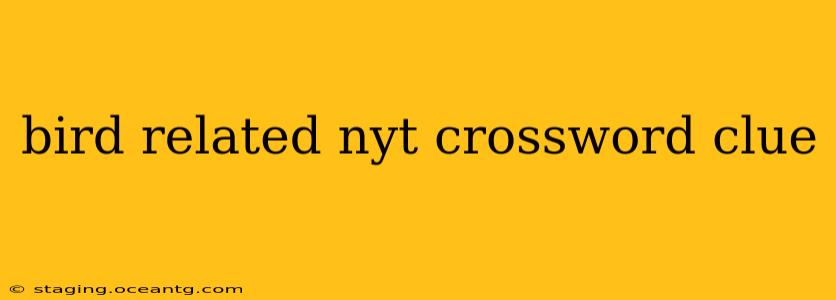Cracking the Code: Bird-Related NYT Crossword Clues
The New York Times crossword puzzle, a daily brain teaser for millions, often incorporates clever clues related to the avian world. These clues can range from straightforward to incredibly cryptic, demanding a deep understanding of ornithology, wordplay, and the puzzle's specific style. This guide explores the common types of bird-related clues and provides strategies for successfully solving them.
Understanding the NYT Crossword's Style
The NYT crossword is known for its elegant wordplay and sophisticated vocabulary. Bird-related clues frequently leverage:
-
Common Bird Names: Expect clues referencing familiar birds like robin, eagle, owl, or dove. These clues might be straightforward ("Red-breasted songbird") or more cryptic ("Bird of peace").
-
Bird Sounds: Clues might allude to bird calls or songs ("Sound of a night bird"). Pay attention to onomatopoeia – words that imitate sounds.
-
Bird Habitats: Clues could refer to where birds live ("Bird of prey found in mountainous regions"). Knowing bird habitats is key.
-
Bird Behaviors: Clues might describe bird actions ("Bird known for its elaborate mating dance"). Observational knowledge of birds is beneficial.
-
Mythological or Literary References: Birds often appear in mythology and literature ("Greek messenger god's bird"). Familiarity with these references can provide an edge.
-
Wordplay: Expect puns, anagrams, and other word games. For example, a clue might play on the double meaning of a word related to birds.
How to Approach Bird-Related Clues
-
Consider the Length: The number of letters in the answer is crucial. This immediately limits the possibilities.
-
Identify Key Words: Analyze the clue for keywords that might hint at specific bird types or behaviors.
-
Think Outside the Box: Don't always expect a straightforward answer. The clue might be a riddle or a pun.
-
Use Crosswords as a Learning Tool: If you encounter unfamiliar birds, use this as an opportunity to broaden your ornithological knowledge.
-
Look for Wordplay: Is the clue playing on a word's double meaning? Is it an anagram?
-
Use the Crossword's Grid: Already-filled-in letters can provide crucial clues to the answer, reducing the number of possibilities.
-
Consider the Difficulty Level: The difficulty of the puzzle will influence the complexity of the clues. A Monday puzzle is likely to have simpler bird clues than a Saturday one.
Examples of Cryptic Bird Clues (and their solutions):
- Clue: "Bird known for its long neck" Solution: SWAN
- Clue: "Bird associated with wisdom" Solution: OWL
- Clue: "Bird that pecks at seeds" Solution: FINCH (or similar, depending on letter count)
- Clue: "Bird's high-pitched call" Solution: This would depend heavily on the number of letters, but think of the sounds birds make (e.g., CHIRP, PEEP).
Frequently Asked Questions (FAQs)
Q: Where can I find more practice with NYT crossword clues? The New York Times website itself archives past puzzles. Many other websites also offer crossword puzzles that are similar in style and difficulty.
Q: Are there resources to help me learn more about birds? Yes! Numerous websites, books, and field guides provide in-depth information about bird species and their behaviors. Local Audubon societies also often offer bird identification walks and workshops.
Q: What's the best way to improve at solving NYT crosswords? Practice is key! Start with easier puzzles and gradually work your way up to more challenging ones. Pay attention to the types of clues used and how they work.
By understanding the structure and wordplay characteristic of the NYT crossword, and by expanding your knowledge of birds, you'll be well-equipped to tackle even the most challenging avian-themed clues. Happy puzzling!
